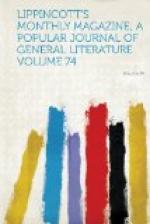The growth of the Roman Catholic Church in America has been so recent that it can show but few historical landmarks. The time-honored cathedral at St. Augustine, Florida, and the magnificent ruin of the San Jose Mission near San Antonio, Texas, and one or two weather-stained little chapels in the North-west, are nearly all the churches that bring to us the story of the priestly work of the Roman ecclesiastics during the colonial days.
We have no State Church, and the different Presidents have made a wide variety of choice in selecting their places of worship in Washington. St. John’s, just opposite the White House, has been the convenient Sunday home of some of them: others have followed their convictions in Methodist, Presbyterian, Unitarian and other churches. But the city of Washington is itself too young to be able to boast any very ancient associations in its churches, and few of its temples have been permitted to record the names of famous occupants during a series of years. Our whole country, indeed, is a land of many denominations and a somewhat wandering population; and older cities than Washington have found one church famous for one event in its history, and another for another, rather than, in any single building, a series of notable occurrences running through the centuries. The nearest approach to the record of a succession of worthies occupying the same church-seats year after year is to be found in the chronicles of our oldest college-chapels, as, for instance, at Dartmouth, where the building containing the still-used chapel dates from 1786. But though poverty and custom unite in making our colleges conservative, their growth in numbers demands, from time to time, new and more generous accommodations for public worship; and so the little buildings of an earlier day are either torn down or kept for other and more ignoble uses, like Holden Chapel at Harvard. This quaint little structure was built in 1744, and is now used for recitation-rooms, but at one period in its career it served as the workshop of the college carpenter.
[Illustration: RUINS OF THE OLD CHURCH-TOWER, JAMESTOWN, VIRGINIA.]
In the years since our grandfathers built their places of worship we have seen strange changes in American church buildings—changes in material, location and adaptation to ritual uses. We have had a revival of pagan temple-building in wood and stucco; we have seen Gothic cathedrals copied for the simplest Protestant uses, until humorists have suggested that congregations might find it cheaper to change their religion than their unsuitable new churches; we have ranged from four plain brick walls to vast and costly piles of marble or greenstone; we have constructed great audience-rooms for Sunday school uses alone, and have equipped the sanctuary with all culinary attachments; we have built parish-houses whose comfort the best-kept mediaeval monk might envy, and we have put up evangelistic tabernacles




